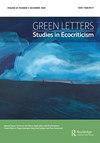本·惠特利的《在地球上》(2021):民间恐怖作为气候变化的警告
Q1 Arts and Humanities
引用次数: 0
摘要
摘要本·惠特利的《在地球上》(2021)是最近几部为民间恐怖类型指明了重要新方向的英国电影之一。通过将民间恐怖与其他恐怖类型和科幻小说相结合,这部电影转向了最近被称为“新怪异”的领域。在这样做的过程中,它围绕人与自然的关系产生了复杂的对话。这部电影质疑了我们概念化和试图理解自然的不同方式,表明这些尝试,无论是宗教的还是科学的,都倾向于将一种不一定存在的模式强加于自然。最终,这一对话产生了一个复杂但有效的警告,即气候变化对人类和自然构成的迫在眉睫的危险,同时试图避免它所批评的过于简单化的模式。关键词:气候变化,生态恐怖,民间恐怖,地球新怪,惠特利,本披露声明,作者未报告潜在的利益冲突。Bitel讨论了在Covid限制期间编写和拍摄《在地球上》这一事实对电影的影响(Bitel Citation2021, 74)。当然,瑞典民间文化在最近的民间恐怖中最突出的应用发生在阿里·阿斯特(Ari Aster) 2019年的美国电影《仲夏之夜》(midsommar)中。参见Hill (Citation2021)。菌根网络在森林树木之间提供通信系统的概念在科学上已经确立,尽管这些网络在多大程度上可以作为一种管理森林的大脑发挥作用尚不清楚。不过,这样的网络在理查德·鲍尔斯(Richard Powers)的《上层故事》(Powers Citation2018)等虚构作品中占有突出地位;它们也在诸如彼得·沃勒本的《树的隐秘生活》(沃勒本2016)等非虚构作品中引起了大众的关注。《在地球上》的立石也让人想起了“母亲树”,苏珊娜·西马德(苏珊娜·西马德是鲍尔斯小说中一个主要角色的灵感来源)将其描述为菌根网络的“枢纽”(西马德引文2021)。相比之下,马克·博尔德(Mark Bould)的激烈论点是,我们这个时代的小说充斥着气候变化的主题,即使这些小说不是“立即和明确地涉及气候变化”(Bould Citation2021, 14)。惠特利告诉比特尔,他对《在地球上》中的模式制作的批评来自于他构思这部电影时的时事:“它来自于淹没在所有特朗普的东西中,观察美国政治和英国政治,思考事实的侵蚀,以及这种叙事的武武化”(比特尔引用2021,74-75)。这部电影与《在地球上》有进一步的联系,因为考虑到它的拍摄时间,许多人也把这颗小行星(遭到美国政府无能的反对)看作是新冠病毒的替身。附加信息:关于贡献者的说明。基斯BookerM。Keith Booker是位于费耶特维尔的阿肯色大学的英语教授。他是60多本书的作者或编辑,并撰写了100多篇关于文学、电影和文化的文章。Isra Daraiseh是科威特阿拉伯开放大学的英语副教授。她的研究重点是资本主义现代化对全球文化的影响。本文章由计算机程序翻译,如有差异,请以英文原文为准。
Ben Wheatley’s In the Earth (2021): Folk Horror as Climate Change Warning
ABSTRACTBen Wheatley’s In the Earth (2021) is one of several recent British films that point the genre of folk horror in significant new directions. By mixing folk horror with other horror genres and with science fiction, this film veers into the territory that has recently been described as the ‘New Weird’. In so doing, it generates a complex dialogue surrounding the relationship between humans and nature. The film interrogates the different ways in which we conceptualise and attempt to understand nature, suggesting that these attempts, whether religious or scientific, tend to involve an imposition of patterns on nature that are not necessarily there. Ultimately, this dialogue produces a complex, but effective, warning about the impending danger posed by climate change to both humans and nature, while attempting to avoid the simplistic pattern-making that it critiques.KEYWORDS: Climate changeeco-horrorfolk horrorIn the EarthNew WeirdWheatley, Ben Disclosure statementNo potential conflict of interest was reported by the authors.Notes1. Bitel discusses the impact on the film of the fact that In the Earth was written and filmed during the period of Covid restrictions (Bitel Citation2021, 74).2. Of course, the most prominent use of Swedish folk culture in recent folk horror occurs in Ari Aster’s 2019 American film Midsommar.3. See Hill (Citation2021).4. The concept that mycorrhizal networks provide communication systems among the trees of a forest is scientifically well-established, though the extent to which these networks can function as a sort of brain governing the forest is not as clear. Such networks, though, have been featured prominently in such fictional works as Richard Powers’ The Overstory (Powers Citation2018); they have also been brought to popular attention in such non-fiction works as Peter Wohlleben’s The Hidden Life of Trees (Wohlleben Citation2016). The standing stone of In the Earth also recalls the ‘mother trees’ that Suzanne Simard (the inspiration for a major character in Powers’ novel) has described as ‘hubs’ of mycorrhizal networks (Simard Citation2021).5. Compare here Mark Bould’s spirited argument that the fiction of our time is permeated with the topic of climate change, even when that fiction is not ‘immediately and explicitly about climate change’ (Bould Citation2021, 14).6. Wheatley tells Bitel that his critique of pattern-making in In the Earth came out of current events during the time he was conceiving of the film: ‘It came out of drowning in all the Trump stuff, watching American politics and British politics, and thinking about the erosion of fact, and this weaponising of narrative’ (Bitel Citation2021, 74–75).7. This film is further linked to In the Earth by the fact that, given its timing, many also saw the asteroid (opposed by the inept attempts of the U.S. government to do something about it) as a stand-in for Covid.Additional informationNotes on contributorsM. Keith BookerM. Keith Booker is Professor of English at the University of Arkansas at Fayetteville. He is the author or editor of over 60 books and the author of over 100 essays on literature, film, and culture.Isra DaraisehIsra Daraiseh is Associate Professor of English at the Arab Open University in Kuwait. Her research focuses, on the impact of capitalist modernization in global culture.
求助全文
通过发布文献求助,成功后即可免费获取论文全文。
去求助
来源期刊

Green Letters
Arts and Humanities-Literature and Literary Theory
CiteScore
0.50
自引率
0.00%
发文量
38
期刊介绍:
Green Letters: Studies in Ecocriticism explores the relationship between literary, artistic and popular culture and the various conceptions of the environment articulated by scientific ecology, philosophy, sociology and literary and cultural theory. We publish academic articles that seek to illuminate divergences and convergences among representations and rhetorics of nature – understood as potentially including wild, rural, urban and virtual spaces – within the context of global environmental crisis.
 求助内容:
求助内容: 应助结果提醒方式:
应助结果提醒方式:


